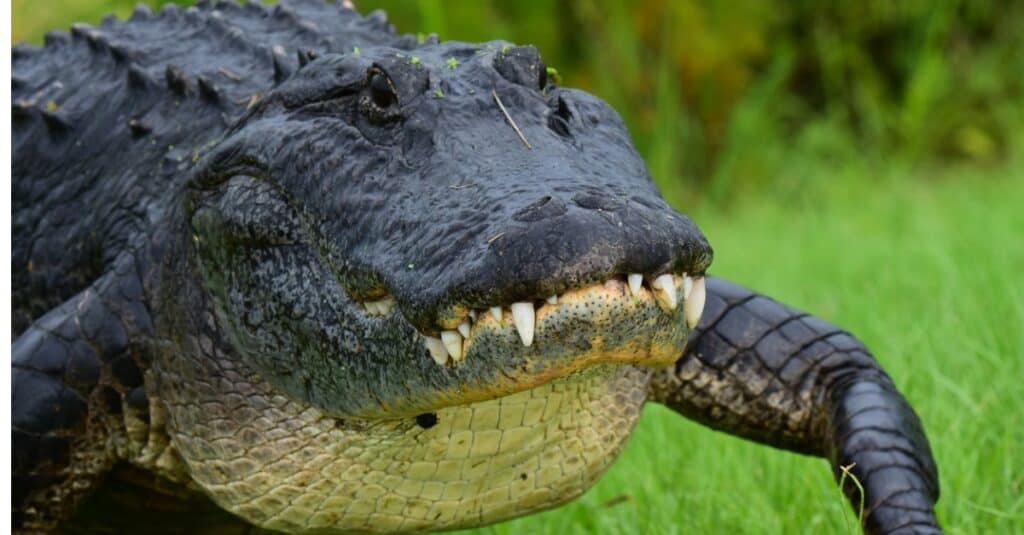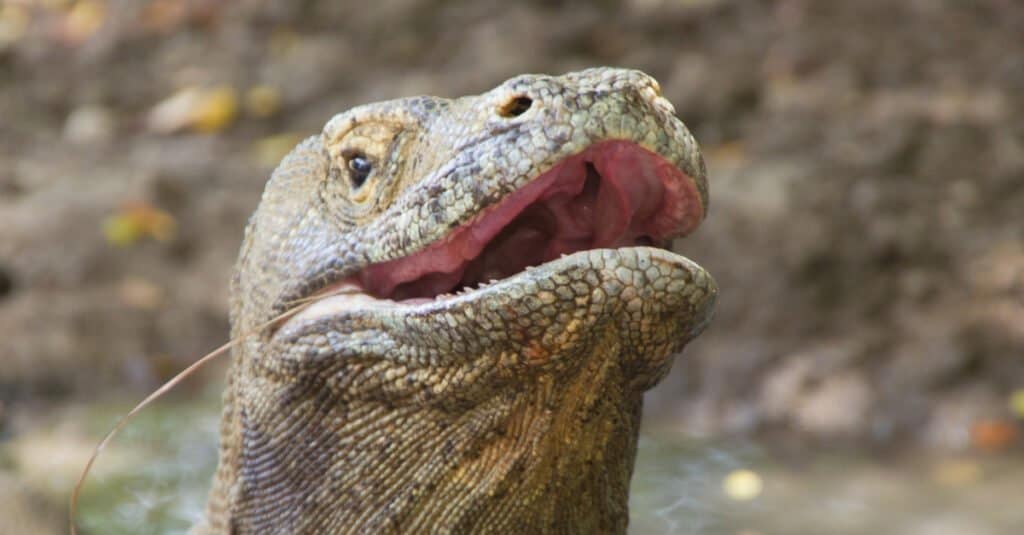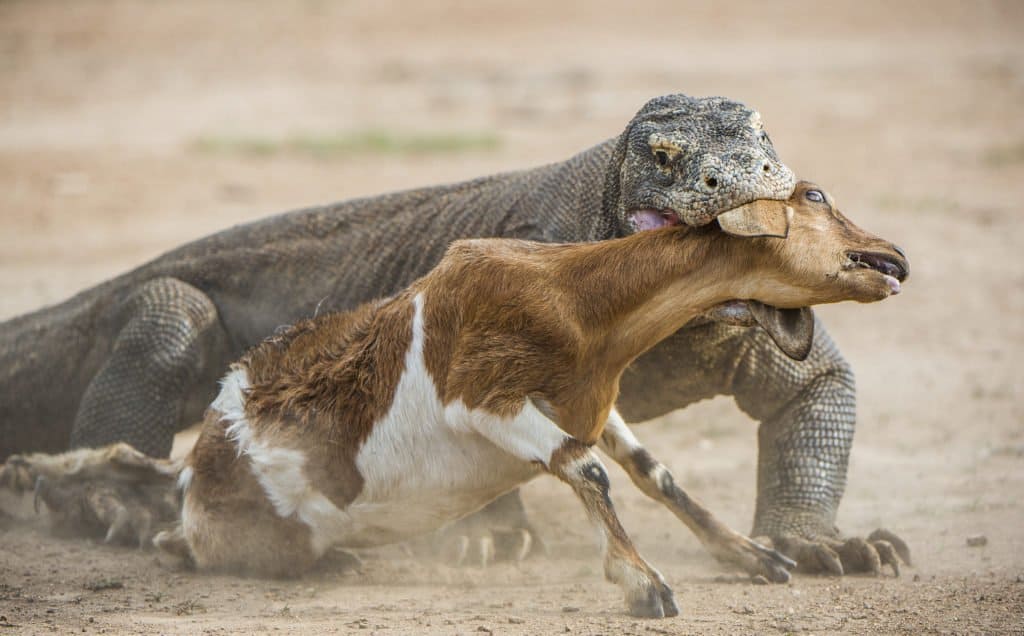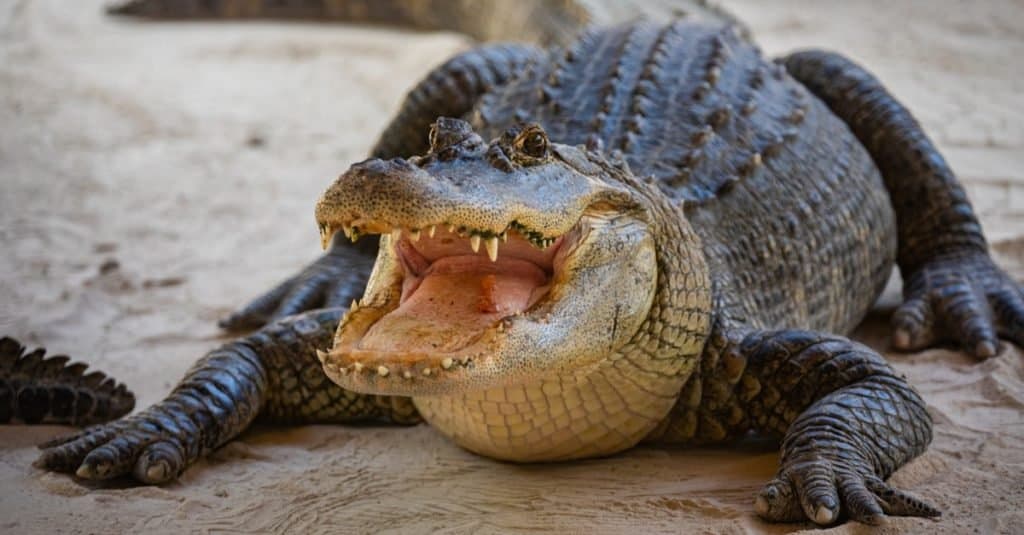Komodo dragons are deadly monitor lizards that regularly prey on animals that are larger than them and can easily kill a human being. Alligators are also large reptiles that use vicious attacks to rip apart their enemies. We’ve already covered what would happen to a Komodo dragon that faced a crocodile, so it’s only fair to wonder how a Komodo dragon vs. alligator fight would occur. We have compiled the most important data, and we’re going to use that to theorize what happens if an alligator and Komodo dragon encounter each other in the wild. Discover which of these reptiles wins!
Comparing a Komodo Dragon and an Alligator

| Komodo Dragon | Alligator | |
| Size | Weight: 150lbs – 300lbs Length: 6ft-10ft | Weight: 400lbs to 800lbs (sometimes more) Height: 1ft – 2ft off the ground Length: 8.2 feet to 11.2 feet long |
| Speed and Movement Type | 11 mph – Crawling motion | – 30 mph over short distances on land – Locomotion includes swimming and quick scampers on the ground. |
| Bite Power and Teeth | – Weak bite power, roughly 100-300PSI – 60 teeth – Razor-sharp, serrated teeth | – 2,980 PSI bite power – Roughly 80 teeth – Teeth roughly 2” in length |
| Senses | – Good eyesight – Use their tongues to “smell” their environment and find prey from miles away – Poor hearing | – Poor vision in water due to protective membrane – Good sight on land – Highly receptive to vibrations – Strong sense of smell. |
| Defenses | – Hard skin with strong scales that are reinforced with bony deposits. – Speed | – Camouflage – Speed – Hissing threat display |
| Offensive Capabilities | – Possibly venomous – Sharp teeth lead to exsanguination in victims – Sharp claws hold prey in place | – Powerful bite – Death roll can instantly amputate – Speed allows for devastatingly quick attacks to occur |
| Predatory Behavior | – Ambush predators – Tries to knock down and bite vital areas on prey, typically the neck. | – Ambush prey by keeping eyes and nostrils above water – Clamp onto enemies and use a death roll |
The Key Factors in a Fight Between a Komodo Dragon and an Alligator

A Komodo dragon vs alligator fight boils down to size, speed, and fighting abilities.
©iStock.com/cturtletrax
Certain physical elements would play more of a role in a Komodo dragon vs. alligator fight than others. We have decided that five physical characteristics, along with each animal’s combat skills, would have the greatest influence on the fight. See how these creatures measure up to one another.
Physical Features of a Komodo Dragon and an Alligator

Komodo dragons have short but very sharp teeth.
©vladivlad/Shutterstock.com
A battle between these two vicious apex predators would come down to size, power, speed, and the ability to ward off attacks. We’ve explored five different physical features of each animal, and you can see how they compare to each other and which has the advantage in a fight.
Komodo Dragon vs. Alligator: Size
A Komodo dragon is the largest monitor lizard on the planet, measuring up to 10 feet in length and weighing upwards of 300 lbs. That is a large reptile, but the alligator is larger. They regularly reach over 700 lbs and grow up to 11 feet long. The largest alligator on record weighed in at 1,380 pounds!
The alligator is a larger animal, and that gives them a serious advantage.
Komodo Dragon vs. Alligator: Speed and Movement
The Komodo dragon can reach 11mph while crawling on the sandy beaches of the areas it inhabits. They are good swimmers, too. Yet, they do not hunt in the water. Alligators are at home in the water, where they can reach a max speed of 20mph. They can move quickly on land, too, reaching 30 mph in short bursts to hunt down enemies.
Alligators have the speed advantage.
Komodo Dragon vs. Alligator: Bite Power and Teeth
The Komodo dragon has short teeth and a weak bite of 350 PSI, but they can rip gaping holes in foes and leave them bleeding with a unique type of venom. Alligators have an incredibly powerful bite that almost hits 3,000 PSI, and their teeth are 2 inches in length. They can bite to crush an enemy or tear limbs off entirely.
The Komodo dragon might have venom, but it’s too slow-acting to kill a gator mid-fight. The alligator has the advantage in teeth and bites.
Komodo Dragon vs. Alligator: Senses
The Komodo dragon is good at “tasting” chemicals in the air, and its eyesight is very good. Alligators have poor vision in the water, but they can see well on land. They also have a strong sense of smell, along with the ability to feel small vibrations to help them pinpoint enemies.
Alligators have better senses than Komodo dragons.
Komodo Dragon vs. Alligator: Physical Defenses
Alligators have tough skin and good camouflage along with speed to keep them safe. Komodo dragons, minus the camouflage, are very similar to the alligators in this respect. Yet, the large lizard has bony deposits that reinforce its scales, making it hard to bite through.
Komodo dragons have better defenses than alligators.
Combat Skills of a Komodo Dragon and an Alligator

A Komodo dragon hunts its prey with speed and precision.
©Sergey Uryadnikov/Shutterstock.com
Both the Komodo dragon and the alligator rely on their teeth to kill their prey. Moreover, they are both ambush predators that viciously attack their prey and know where the vital areas are to deal tremendous damage. The Komodo dragon can be a slow killer, relying on exsanguination from bites to kill its enemies. Alligators are quick and powerful; they overwhelm and then dismember their enemies while disorienting them in the water.
Alligators have the advantage in terms of fighting skills.
What Are Key Differences Between a Komodo Dragon and an Alligator?

Alligators are longer and heavier than Komodo dragons, and they have teeth meant for puncturing and holding enemies.
©iStock.com/unclegene
Alligators are mostly aquatic reptiles, but they will gladly find food on land. Komodo dragons are terrestrial reptiles, but they also swim when necessary. Alligators are longer and heavier than Komodo dragons, and they have much larger teeth. Komodo dragons have sharp, serrated teeth but alligators have conical teeth meant for biting and latching onto an enemy.
Although the two share some similarities, such as being apex predators, having tough skin, and walking on four legs, they live in different parts of the world. Alligators live in the United States and some parts of China, but Komodo dragons live in Southeast Asia. These are the most important differences between the creatures.
Who Would Win in a Fight Between a Komodo Dragon and an Alligator?

An alligator would beat a Komodo dragon in a fight.
©Mia2you/Shutterstock.com
An alligator would beat a Komodo dragon in a fight. The crushing power of an alligator’s bite is too much for the smaller, lighter Komodo dragon to compete against. The alligator would probably wait for a Komodo dragon to come to the water’s edge before striking. If that happens, the alligator will drag the lizard into the water and dismember it by biting and death-rolling its limbs until the creature dies.
If the two met on an open plain for some reason, the alligator would close the distance with its incredible speed and engage the Komodo dragon in battle. They would both launch a flurry of bites, and the alligator would start badly bleeding. Although the Komodo dragon’s scales might turn away a few attacks. Eventually, the alligator will land a bone-breaking bite. The Komodo dragon can be killed or incapacitated by a bite to the head, neck, or limb.
The bottom line is that a fully grown American alligator would handily beat a Komodo dragon in a fight, but it would probably have some serious wounds.
Who Could Beat an Alligator in Battle?
The alligator is a formidable creature. They have powerful jaws and razor-sharp teeth. They can move quickly in the water and are incredibly resilient creatures. So which animals could possibly stand up to an alligator?
One contender might be the hippopotamus. The massive size of this animal gives it an advantage over alligators in terms of sheer strength and power. In addition, they have thick skin, which helps them protect themselves against bites from other predators. Other contenders might include bears or rhinoceroses due to their tough hides and large size.
Another possible battle would be between an alligator and a large bird such as an eagle or condor. While not as strong as some of the land-based animals mentioned above, these birds have impressive wingspans that they can use to keep out of reach of an alligator’s deadly bite while also using their talons for an offense if necessary.
Ultimately though, who knows who would win such a fictional battle? It’s impossible to say for certain, but one thing is for sure, any animal that goes up against an alligator will have its work cut out for it!
What do Komodo Dragons Eat?
Komodo dragons feed on the carcasses of dead animals and reptiles, such as snakes and lizards. They have been observed to hunt and devour larger animals like deer, pigs, goats, and other Komodo dragons. Additionally, they will scavenge for eggs and invertebrates if available in their environment. Their keen sense of smell allows them to detect food from long distances, and they are known to take advantage of any chance to eat. If a rodent or mammal crosses their path, they will not hesitate to eat them.
What do Alligators Eat?
The typical diet of a large alligator consists mainly of fish, turtles, frogs, and salamanders. Whenever they get the chance, they will eat birds, mammals, and insects. Alligators will also scavenge for carrion. They are opportunistic feeders that hunt both during the day and night. Even though they can be formidable predators, alligators will often seek out smaller prey items in order to conserve energy. As such, their diets may also include insects, worms, and other invertebrates like crayfish or crabs. Alligators have even been known to consume fruit from time to time!
Komodo Dragon Conservation Status and Threats
The International Union for Conservation of Nature’s Red List has labeled Komodo dragons as Endangered due to the risks posed by human activity. These include the destruction of their habitat, caused largely by agriculture, and overhunting of their prey species, such as deer and wild boar. It is believed that only around 5000 of these creatures are left in the wild, with some suggesting that the number on the island of Komodo may be as low as 700. These dire numbers have placed the Komodo dragon among the most threatened lizards in the world.
Alligator Conservation Status and Threats
American Alligators are not endangered, but they do have a conservation status of threatened. This is due to the species having been hunted to near extinction in the 1950s. They are now protected by state and federal laws, allowing their population to recover and stabilize.
The main threats facing American Alligators today include habitat destruction due to human development, pollution from agricultural runoff and chemical contaminants, illegal poaching for skins or meat, disease outbreaks, competition with exotic species (such as feral pigs), and being killed by vehicles while crossing roads. Conservationists are currently working on various projects designed to protect alligator habitats and reduce the impact of these threats so that this remarkable species can continue living in its natural environment for years to come.
The photo featured at the top of this post is © Sergey Uryadnikov/Shutterstock.com
Thank you for reading! Have some feedback for us? Contact the AZ Animals editorial team.






